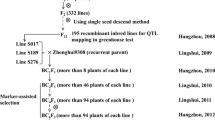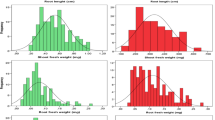Abstract
Phosphorus (P) deficiency of soils is a major yield-limiting factor in rice production. Increasing the P-deficiency tolerance of rice cultivars may represent a more cost-effective solution than relying on fertilizer application. The objective of this study was to identify putative QTLs for P-deficiency tolerance in rice, using 98 backcross inbred lines derived from a japonica×indica cross and genotyped at 245 RFLP marker loci. Lines were grown on P-deficient soil and P uptake, internal P-use efficiency, dry weight, and tiller number were determined. Three QTLs were identified for dry weight and four QTLs for P uptake, together explaining 45.4% and 54.5% of the variation for the respective traits. Peaks for both traits were in good agreement which was to be expected considering the tight correlation of r=0.96 between dry weight and P uptake. For both traits the QTL linked to marker C443 on chromosome 12 had a major effect. Two of the three QTLs detected for internal P-use efficiency, including the major one on chromosome 12, coincided with QTLs for P uptake; however, whereas indica alleles increased P uptake they reduced P-use efficiency. We concluded that this was not due to the tight linkage of two genes in repulsion but rather due to an indirect effect of P uptake on P-use efficiency. Most lines with high use efficiency were characterized by very low P uptake and dry weight and apparently experienced extreme P-deficiency stress. Their higher P-use efficiency was thus the result of highly sub-optimal tissue-P concentrations and did not represent a positive adaptation to low P availability. The number of tillers produced under P deficiency is viewed as an indirect indicator of P-deficiency tolerance in rice. In addition to the major QTL on chromosome 12 already identified for all other traits, two QTLs on chromosome 4 and 12 were identified for tiller number. Their position, however, coincided with QTLs for tiller number reported elsewhere under P-sufficient conditions and therefore appear to be not related to P-deficiency tolerance. In this study P-deficiency tolerance was mainly caused by differences in P uptake and not in P-use efficiency. Using a trait indirectly related to P-deficiency tolerance such as tiller number, we detected a major QTL but none of the minor QTLs detected for P uptake or dry weight.
Similar content being viewed by others
Author information
Authors and Affiliations
Additional information
Received: 9 February 1998 / Accepted: 29 April 1998
Rights and permissions
About this article
Cite this article
Wissuwa, M., Yano, M. & Ae, N. Mapping of QTLs for phosphorus-deficiency tolerance in rice (Oryza sativa L.). Theor Appl Genet 97, 777–783 (1998). https://doi.org/10.1007/s001220050955
Issue Date:
DOI: https://doi.org/10.1007/s001220050955




